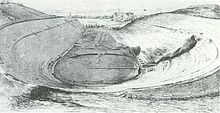Panathinaic Stadium
The Panathinaiko Stadium ( Greek Παναθηναϊκό Στάδιο ) in Athens (also known as Kallimarmaro , "beautiful marble" ) is the Olympic stadium of the first modern Olympic Games in 1896. It was built as a reconstruction on the foundations of the ancient stadium and is located on Outskirts of Athens city center.
Antiquity
The original stadium, located about one kilometer east of the Acropolis , was built around 330 BC. It was built in a natural hollow between the hills of Agras and Ardittos to hold the annual Panathenaic Games , the most important celebration of ancient Athens. Between 140 AD and 144 AD, the stadium received its final appearance ( Hippodrome of Herodes Atticus) during further expansion measures by the patron Herodes Atticus , as it was during excavations by the German architect and building researcher Ernst Ziller from 1869 to 1870 in Appearance occurred. The ancient stadium had the shape of a horseshoe with a running track length of 204.07 meters and a width of 33.35 meters. According to current estimates, the ancient stadium held 50,000 spectators. Under the Romans , an arched wall was built at the western, open end of the stadium and the stadium was henceforth used as an arena .
Modern times
Shortly after its excavation, the second and third Olympics took place in the provisionally prepared stadium in 1870 in front of around 25,000 spectators.
In view of the hosting of the first modern Olympic Games, the stadium was completely renovated in 1895. The stadium in the shape of a horseshoe, which was restored by the architect Anastasios Metaxas according to plans by Ziller, has an interior length of 236 meters. It is characterized by a very narrow curve radius of the career. The grandstands with space for around 50,000 spectators were to be completely clad in marble with the help of the Greek financier Georgios Averoff, who donated 920,000 drachmas . However, as time was running out at the end, parts of the structure had to be built from wood and architecturally hidden as well as possible. In addition to the athletics competitions, the weightlifting, wrestling and gymnastics competitions were held in the Panathinaiko Stadium. The missing marble stands were added later, so that the stadium was completed for the unofficial Olympic Intermediate Games in 1906 .
On April 4, 1968, the basketball players of the AEK Athens met in Kallimarmaro as part of the final of the European Cup Winners' Cup on Slavia Prague . A massive number of spectators, most likely around 80,000, according to other sources between 65,000 and 120,000, watched the match, which AEK won 89:82. This set the official world record for a basketball game, which was replaced by the NBA All-Star Game with 108,000 spectators in 2010 at the latest .
The opening ceremony of the 1997 World Athletics Championships was held in the stadium. For this purpose, a temporary stage was built along the narrow side. Concerts were also held in the stadium, for example by Bob Dylan , Depeche Mode , Tina Turner and Black Sabbath .
When the 2004 Summer Olympics were held in Athens again, the archery competitions were held here (4,000 spectators). In addition, the finish line for the two marathons (40,000 spectators) was located here .
Todays use
The Panathinaiko Stadium is rarely used for events. Current regulations call for a strong restriction on the number of tickets used, which, from the point of view of the organizers, usually makes them uneconomical. The events usually only use a small part of the stadium.
However, there are always exceptions, B. the reception of the Greek national football team , which sensationally won the 2004 European Football Championship . The stadium is also the destination of the annual Athens Marathon from Marathon to Athens. This marathon has been held since 1982.
The stadium on the outskirts of the city center is now a popular tourist destination. In addition, a gate in the grandstands provides access to a museum that provides information about the modern Olympic Games, especially the first ones to be held in Athens, and contains a collection of advertising posters and torches from all of the modern summer and winter Olympic Games.
literature
- Ernst Ziller: Excavation at the Panathenaic Stadium at the expense of SH of the King of Greece . In: Zeitschrift für Bauwesen 20, 1870.
Web links
- panathenaicstadium.gr: The Panathenaic Stadium (English)
- stadia.gr: Panathenaic Stadium (English)
- basementgeographer.com: Panathinaiko Stadium: Birthplace of the Modern Olympics (English)
- athens-greece-guide.com: The Kalimarmaro or Panathinaikos Stadium (English)
Individual evidence
- ↑ Friedbert Ficker; Gert Morzinek; Barbara Mazurek: Ernst Ziller - A Saxon architect and building researcher in Greece; The Ziller family . Kunstverlag Josef Fink, Lindenberg i. Allgäu 2003, p. 18. (there drawing by Ziller).
- ^ Franz-Joachim Verspohl : Stadium buildings from antiquity to the present - direction and self-awareness of the masses . Anabas Verlag, Giessen 1976, p. 163 .
- ↑ 4/4/1968: Η ΑΕΚ, «Βασίλισσα» της Ευρώπης! Report on www.aekbc.gr (Greek)
- ↑ Vladimir Stankovic, basketball journalist on euroleague.net
Coordinates: 37 ° 58 ′ 6 ″ N , 23 ° 44 ′ 28 ″ E







